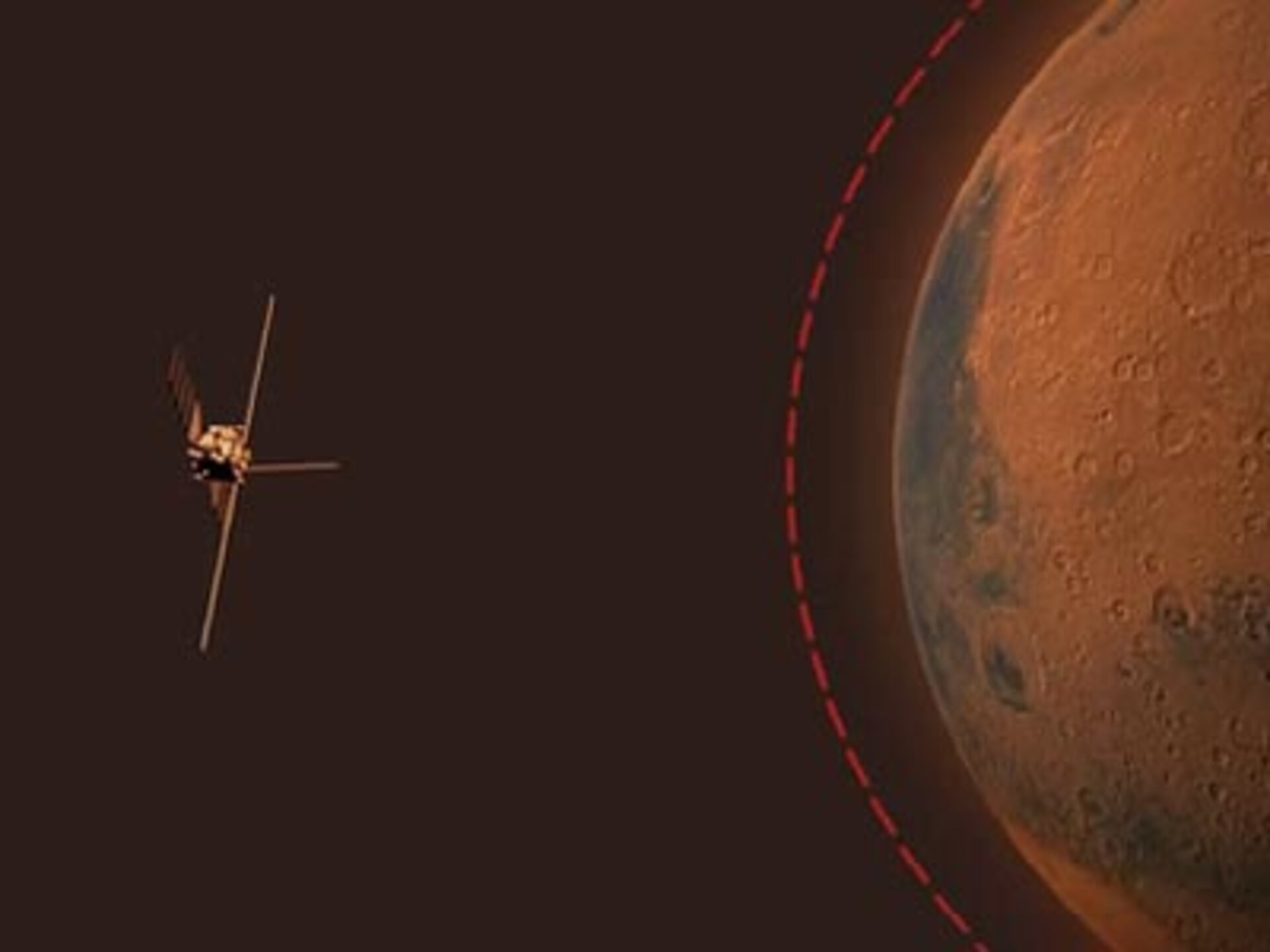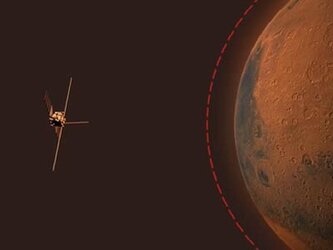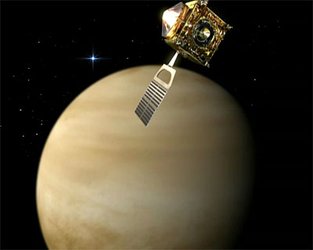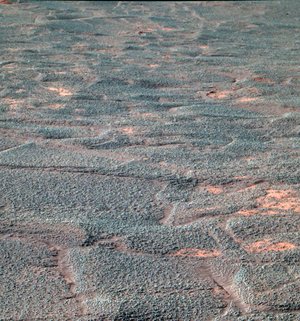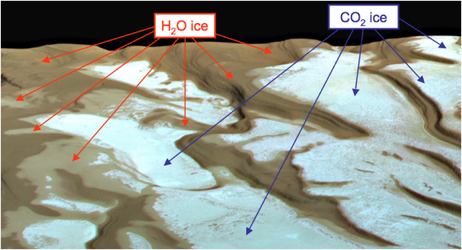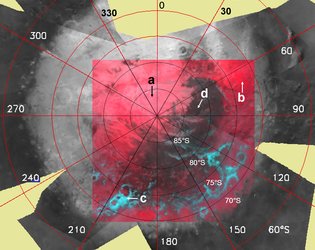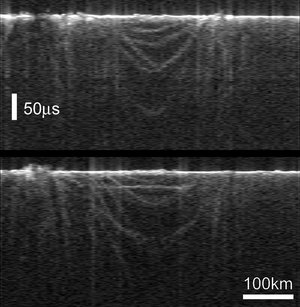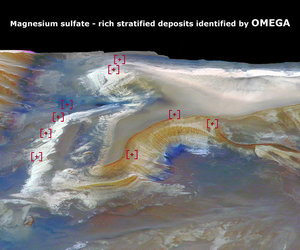Mars Express: First global map of martian ionosphere
With ESA’s Mars Express, scientists continue to gain new insight into the mysterious Martian environment. Some of the most exciting results are being sent back by the MARSIS (Mars Advanced Radar for Subsurface and Ionospheric Sounding) experiment.
MARSIS transmits low frequency radio waves towards the planet’s surface and records the echoes of the different layers.
Although Mars is sometimes described as the most Earth-like of all the planets, there are many differences between the two worlds which scientists are trying to understand. One of the less familiar aspects of both planets is that they possess an ionosphere - a layer of ionised (electrically charged) particles - in their upper atmospheres.
Earth’s ionosphere has been studied intensively and is invaluable as a reflector of radio waves, but, until recently, little was known about the Martian ionosphere.
Previous measurements indicated that Mars’ ionosphere generally lies about 110 to 130 km above the planet. In this region, high-energy solar radiation and particles in the solar wind split the atoms and molecules in the upper atmosphere, releasing free electrons. One of the most surprising results from Mars Express has been the discovery of an ionosphere above the planet’s hemisphere which is in the dark.
Although the main task of MARSIS is to probe beneath the planet’s surface in search of unseen geological materials and structures, the radar is also a valuable tool for learning about the ionosphere. This is because the radio waves from MARSIS are reflected and modified as they pass through the ionised layer.
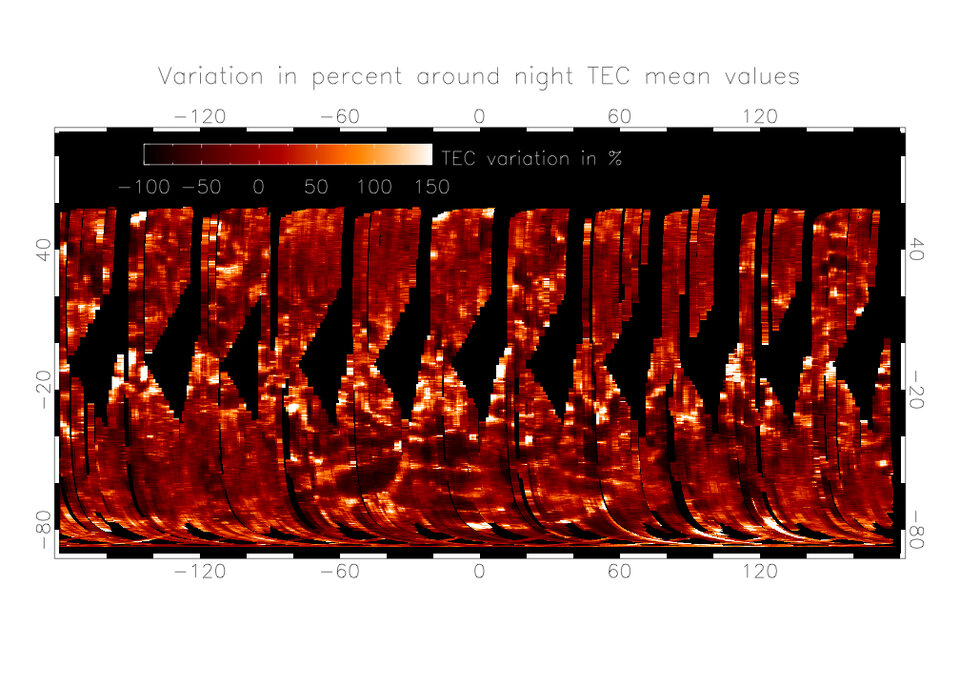
Now, after some two years of operation, an international team of scientists has been able to analyse more than 750 000 echoes from MARSIS in order to make the first direct measurement of the global distribution of electrons in the Martian ionosphere – or the total electron content (TEC).
The distribution of the TEC has been determined by using a novel ‘transmission-mode’ technique to sound the ionosphere, instead of the more common ‘reflection mode’. In the transmission mode, the radar transmits a pulse that travels through the ionosphere twice, once on the way down to the surface and again on the way back.
The received echoes are weakened, delayed and dispersed, depending on the electron density in the ionosphere directly below the spacecraft. In the process of correcting the radar signal, the team has been able to estimate the TEC and its global distribution with an unprecedented spatial resolution of about 5 km.
“We have been able to analyse the MARSIS data to obtain the first large-scale coverage of the ionosphere above the planet’s night side,” said Ali Safaeinili of NASA’s Jet Propulsion Laboratory, lead author on a scientific paper presenting the new results. “The ionosphere on the night side of Mars has never been mapped before.”
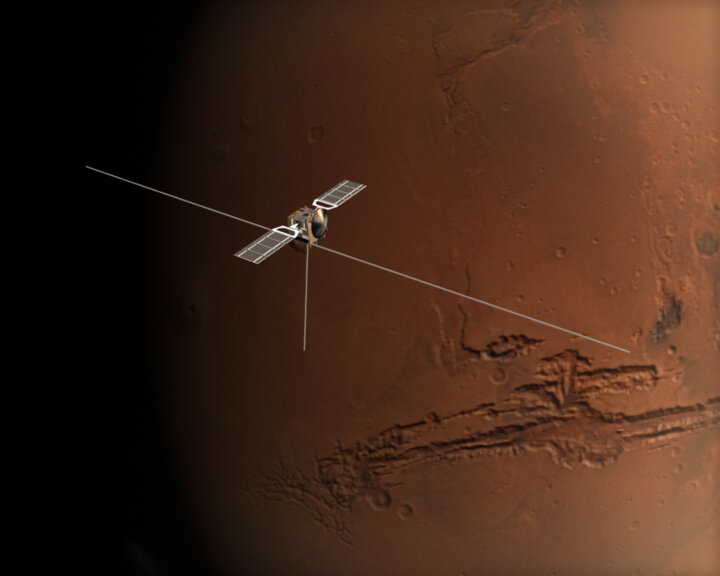
The mapping of the geographical variations in the night side TEC data reveals an intricate web of regions with high electron density. One of the most interesting discoveries has been the close correlation between the number of electrons in the night-side ionosphere and the direction of the local Martian magnetic field.
“We confirmed that the regions of high electron density are associated with strongly magnetised areas, especially south of the equator, near places where the magnetic field lines are perpendicular to the surface,” said Wlodek Kofman of the Laboratoire de Planetologie de Grenoble, CNRS a co-author on the paper.
“On Earth, this situation is only found at the two magnetic poles,” he added.
The draping of the solar wind around the planet presumably allows the ionosphere to form above the night-side. The interaction with the solar wind energises the atmosphere and produces a population of free electrons.
In the coming years, as the low point of the spacecraft’s orbit drifts further into the night side, MARSIS is expected to provide an even more precise map of the ionosphere and the regions where the solar wind connects to the Martian magnetic field.
Notes for editors:
These results will be published in the Geophysical Research Letters in an article titled ‘Estimation of the Total Electron Content of the Martian Ionosphere Using Radar Sounder Surface Echoes’ presented at the ongoing European Mars Science & Exploration Conference: Mars Express and ExoMars at ESA's European Space Research and Technology Centre.
The authors are: A. Safaeinili, W. Kofman, J. Mouginot, Y. Gim, A. Herique, A. Ivanov, J. Plaut and G. Picardi.
Mars Express has been orbiting the red planet since December 2003. It carries seven scientific experiments, including MARSIS. The primary purpose of MARSIS is to investigate the subsurface of Mars up to a depth of 5 km in order to detect buried materials, such as water ice or liquid. It is the first instrument ever designed to actually look below the surface of Mars.
MARSIS was developed jointly by the Italian Space Agency and NASA, under the scientific supervision of the University of Rome 'La Sapienza', in partnership with the Jet Propulsion Laboratory and the University of Iowa, USA.
For more information:
Ali Safaeinili, MARSIS Co-Investigator, Jet Propulsion Laboratory, USA
Email: Ali.Safaeinili @ jpl.nasa.gov
Giovanni Picardi, MARSIS Principal Investigator, University of Rome ‘La Sapienza’
E-mail: Picar @ infocom.uniroma1.it
Jeffrey Plaut, MARSIS co-Principal Investigator, Jet Propulsion Laboratory, USA
E-mail: Plaut @ jpl.nasa.gov
Wlodek Kofman, MARSIS Co-Investigator, Laboratoire de Planetologie de Grenoble, CNRS, France
Email : Wlodek.Kofman @ obs.ujf-grenoble.fr
Donald Gurnett, MARSIS Co-Investigator for ionosphere studies, Univ. of Iowa, USA
E-mail: Donald-Gurnett @ uiowa.edu
Agustin Chicarro, ESA Mars Express Project Scientist
E-mail: Agustin.Chicarro @ esa.int
Fred Jansen, ESA Mars Express Mission Manager
E-mail: Fjansen @ rssd.esa.int


